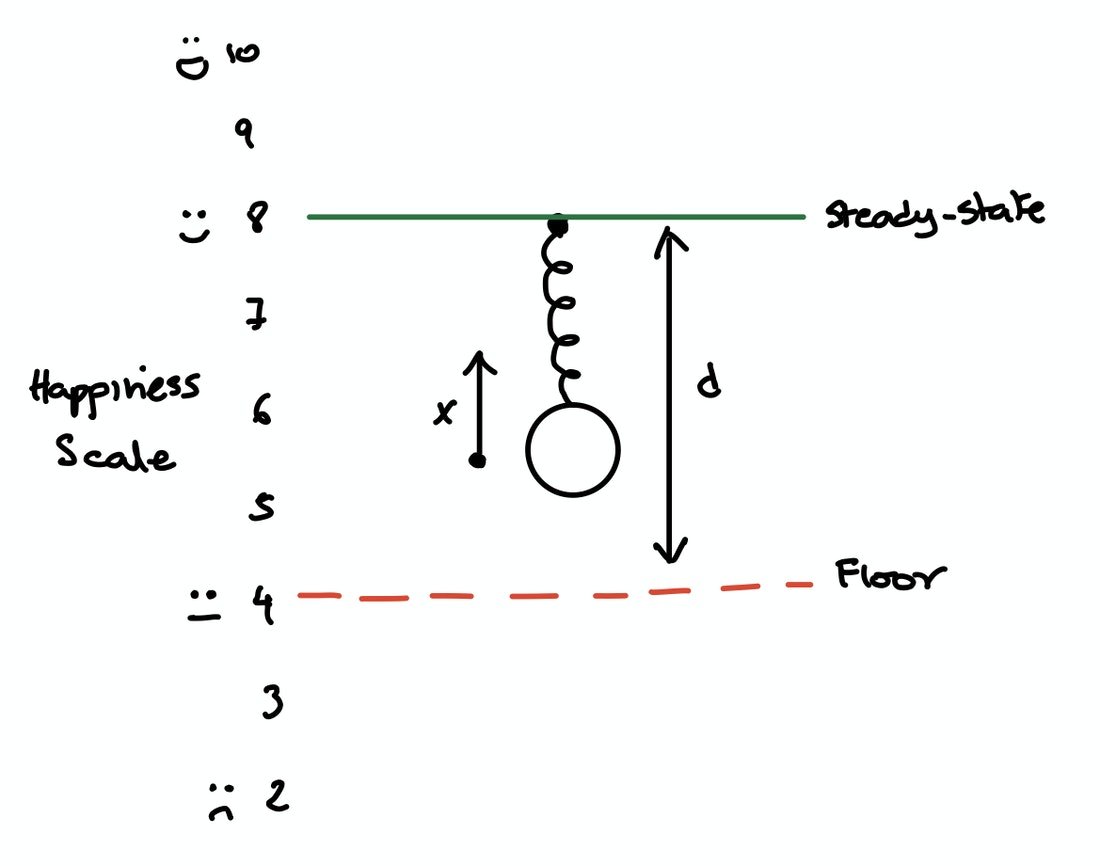Maintaining Happiness
Hey friends,
Today I want to talk to you about happiness levels and how to build a more resilient framework to staying happy. Let me introduce you to a simple drawing (pardon my skills):
Based on the drawing above, imagine your mood (the ball) hanging on a spring and pegged to a Steady-State happiness level. This is how we feel on a regular basis: 10 being the happiest, and 1 being sad. My personal steady-state is an 8 or around there; meaning, I am generally a pretty happy person and rarely will you ever see me sad.
But, that doesn’t mean I don’t get sad, or don’t have my own struggles from time-to-time. Like yourself, I have my tough days and moments that challenge me and pull me down. For example, earlier this year a lead investor pulled out of my fundraising round and ultimately killed the entire round, or, a year ago I lost a big customer for my business, and more recently, I went on a date and she never showed up (I was shooketh! 🤣). Anyways, you get the idea. But, in all of those tough moments I’ve learned two things about myself:
Delta from Steady-State (variable d in drawing): in tough moments and struggles, your mood and happiness level will fall a distance d from steady-state. That distance will be different for everyone; people who worry a lot and take a lot of stress will have a much deeper delta and feel extremely sad when bad things happen vs. others. Over the years I’ve shortened my delta and that’s because I’ve started to care less about the failures and have become more comfortable with them. They are bound to happen and the best thing one can do is to learn from them and not let them take over your happiness, at least not that deeply. So, the first rule of daily happiness is that if you fail or have a negative event, learn to care less about it, it is not the end of the world. This will reduce your delta and bring up your happiness floor (see drawing).
Return to Steady-State (variable x in drawing): how quickly one reverts to normal is the next important thing to staying happy. No matter what failure you encounter, how quickly does your spring bring you back to steady-state is critical. The longer we stay in our depressed state, the harder it becomes to come back to our happy steady-state. I’ve improved on my ability to revert to steady-state by first accepting the challenge. No matter how much I get pushed down, I have a mindset of “Bring it! Let’s go! Round 2!”; this mindset of facing the challenge and not letting it overcome me gives me strength and starts to spring me back to normal. Second, I over-correct by involving myself in healthier habits (exercising, sleeping, spending time with positive people, eating healthy, etc.) during the tough times to recharge my mindset vs. leaning towards vices and temporary pleasures (alcohol, drugs, etc.).
I think about the above on a regular basis, especially during times of failure and loss, and remind myself to never fall too far from the steady-state, and spring back to normal as quickly as possible. The more I do this, the longer I stay happy.
So, for this week, I’d love for you to write down on a piece of paper what your steady-state happiness level is. And, if you face some headwinds in life this week or this month, I’d love for you to try the above strategy and see if it improves your daily life.
Stay smiling my friends! 😊
Sherjan

